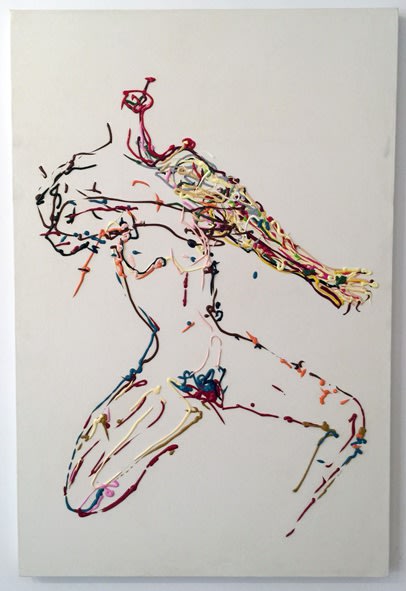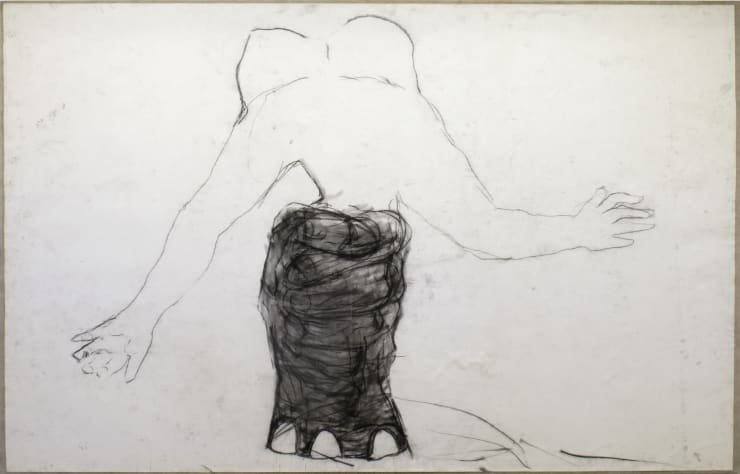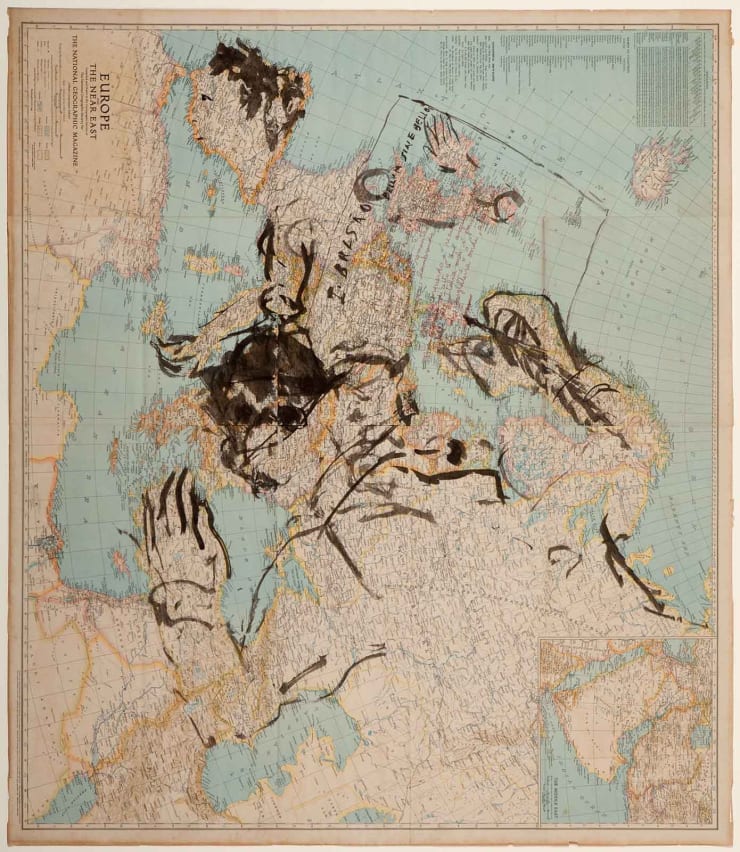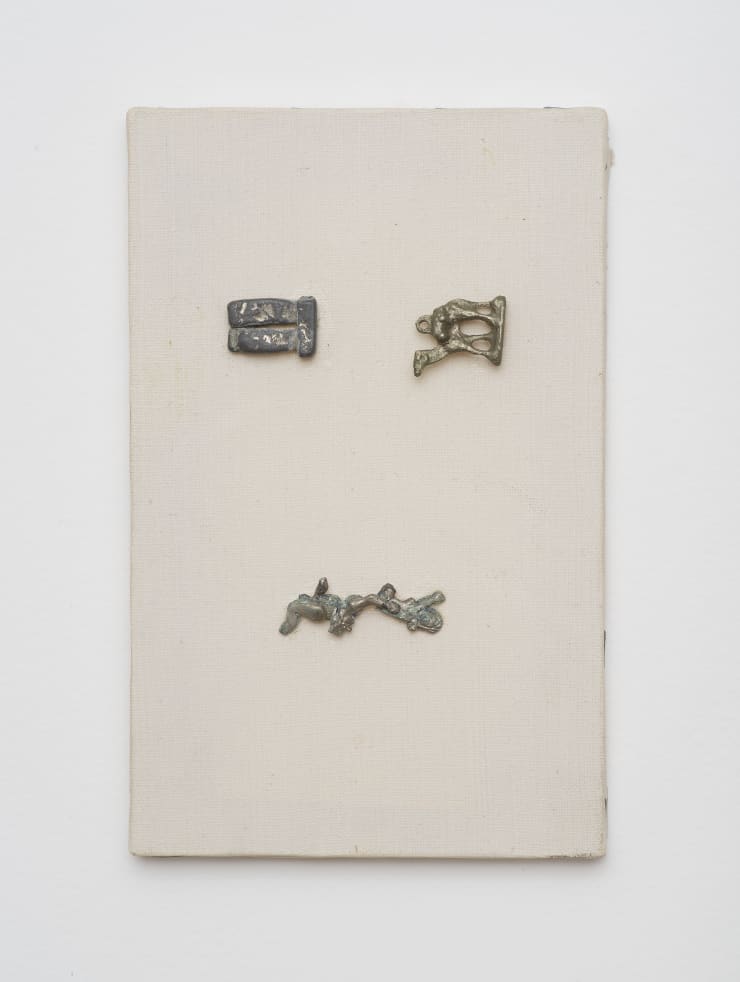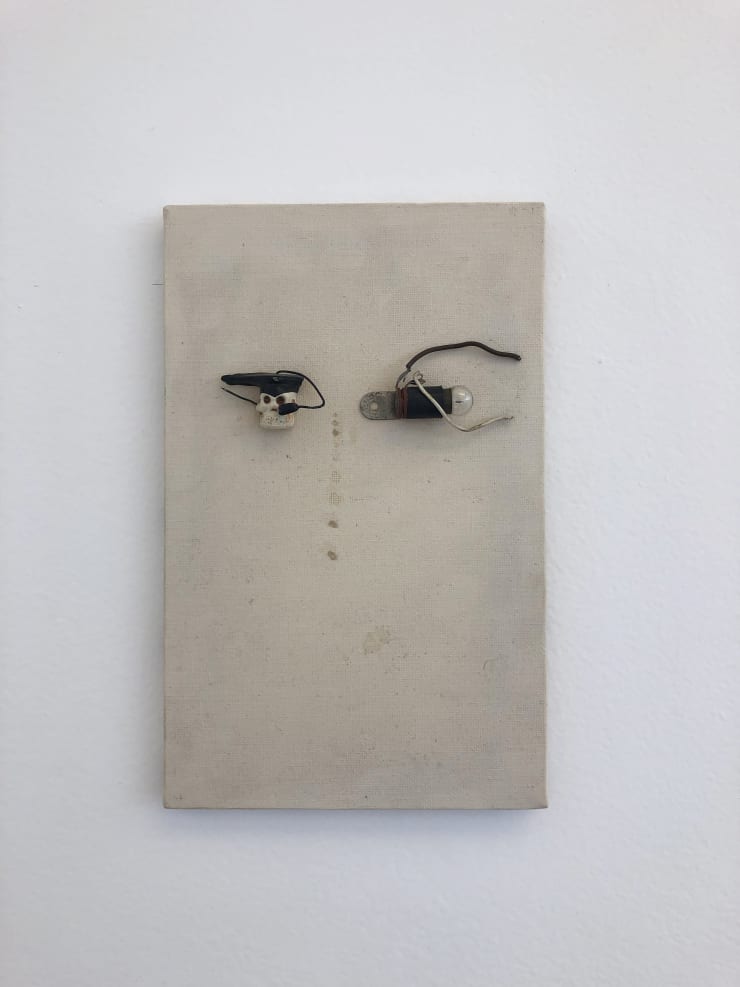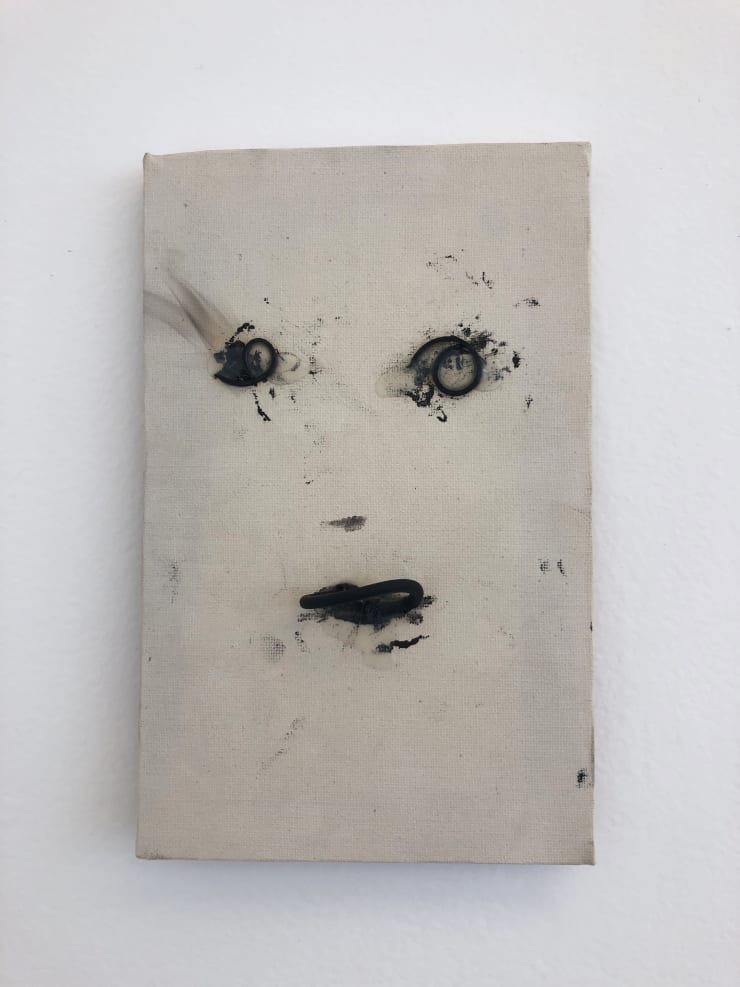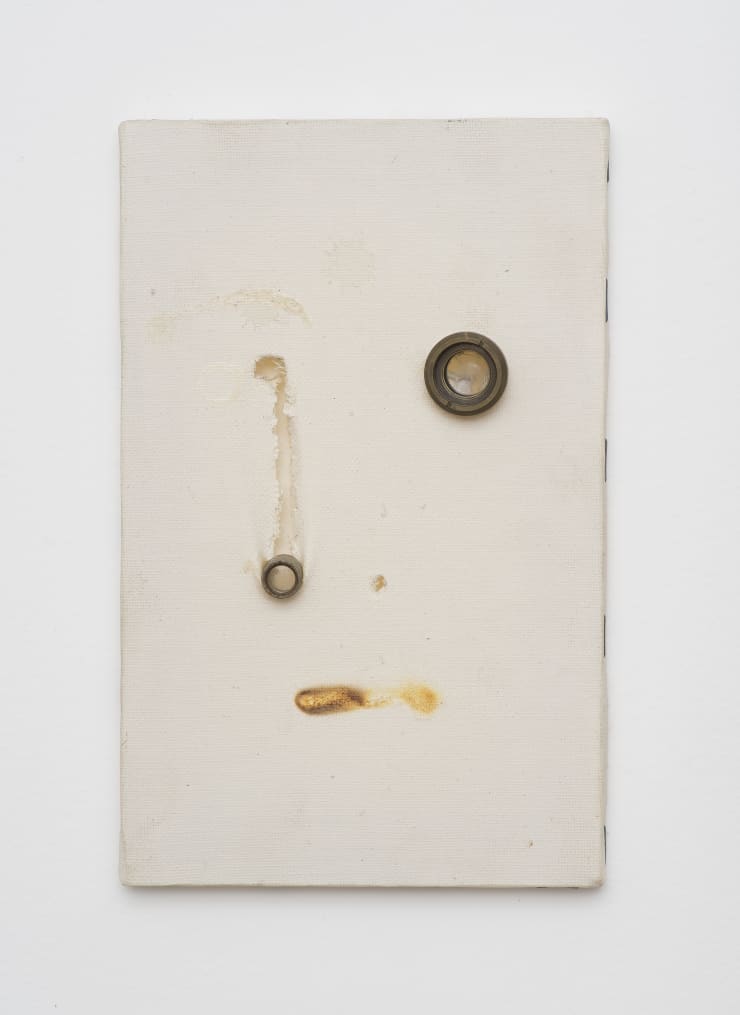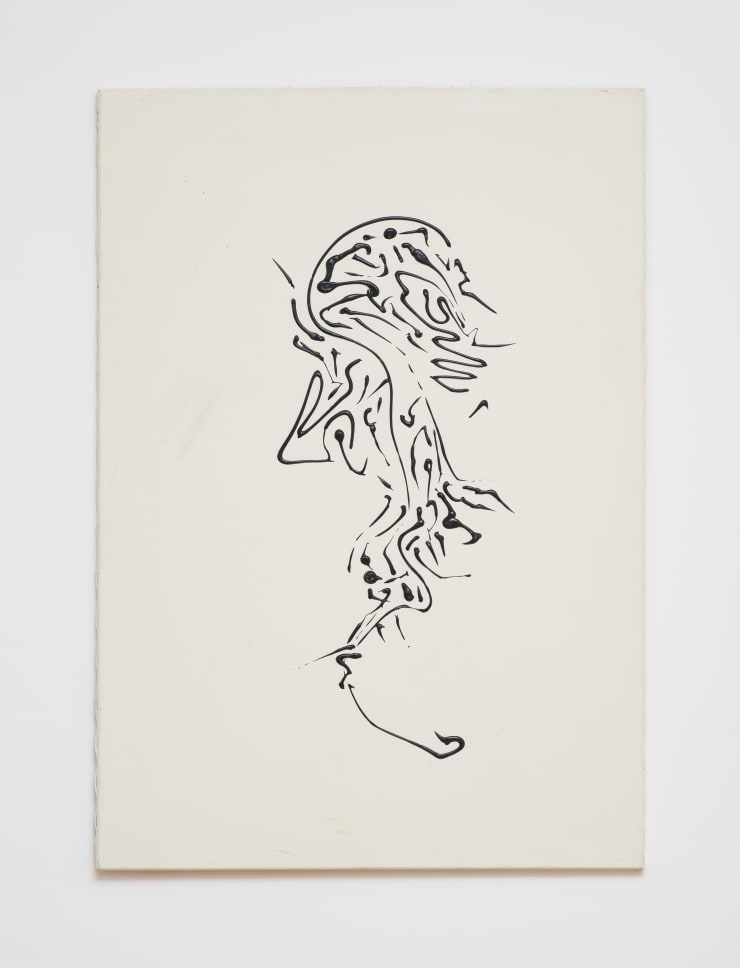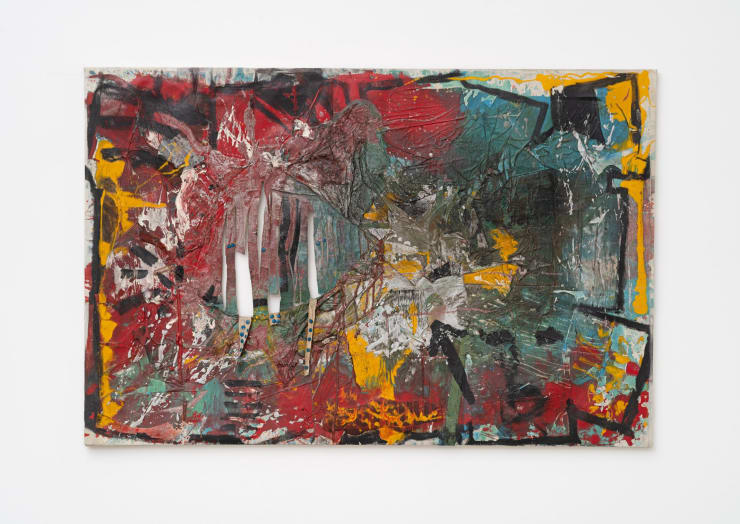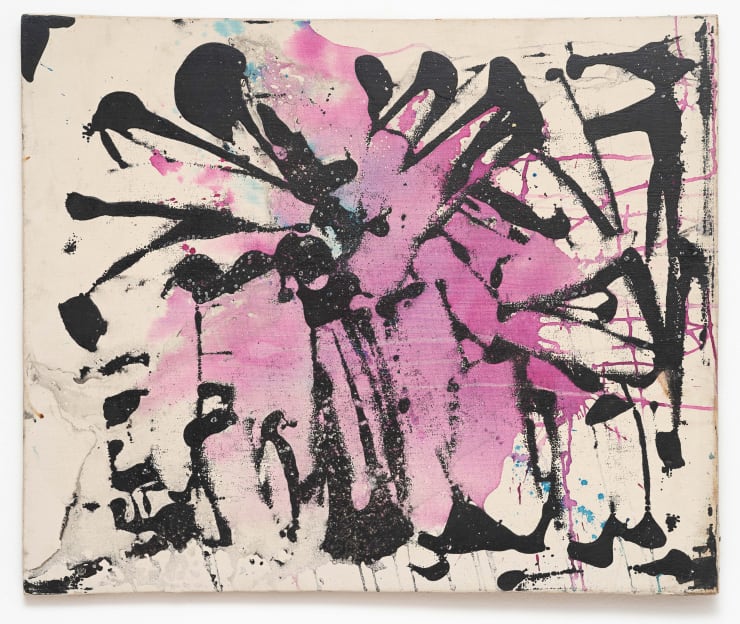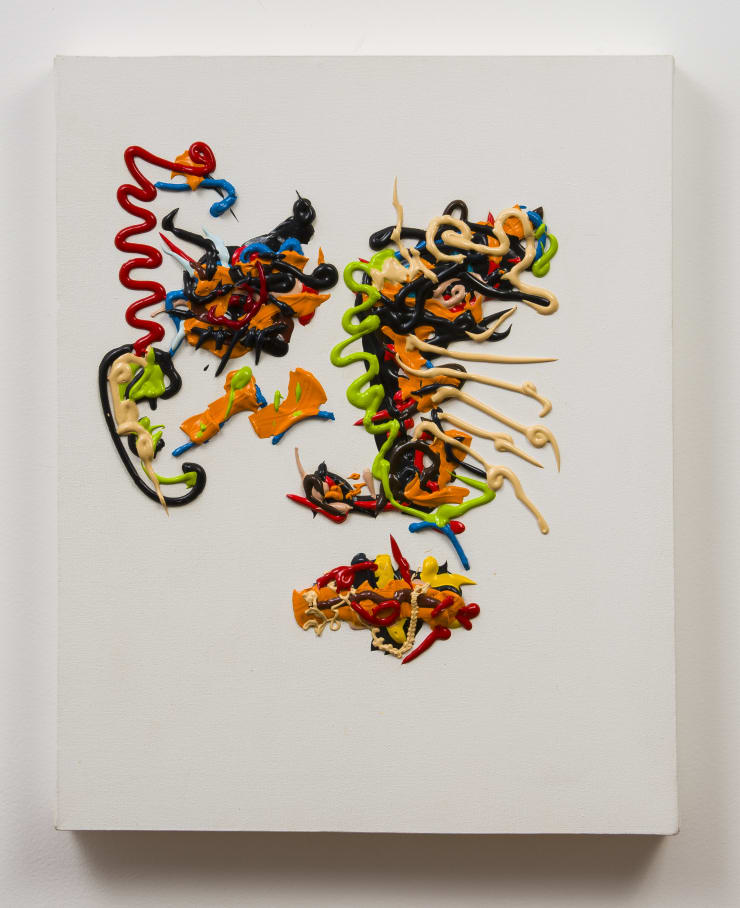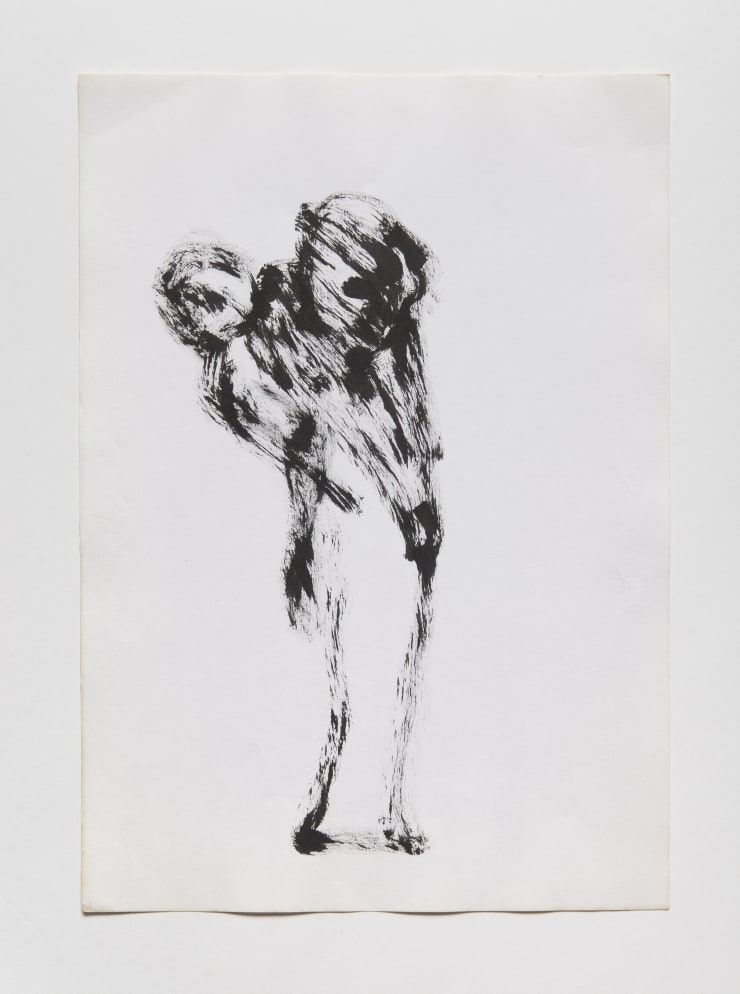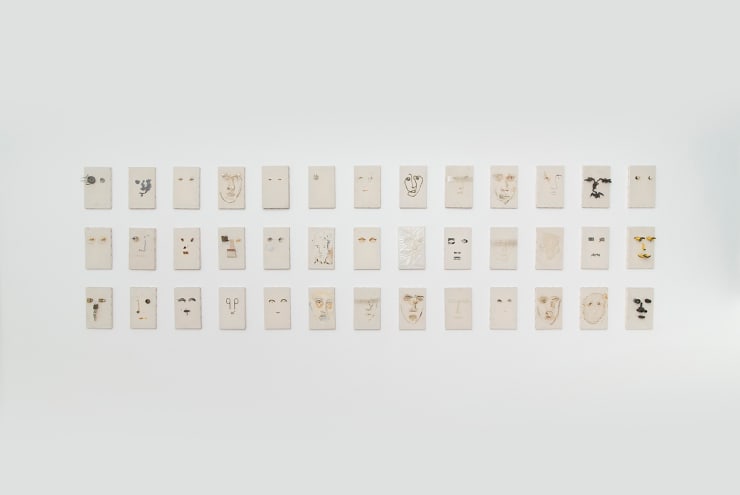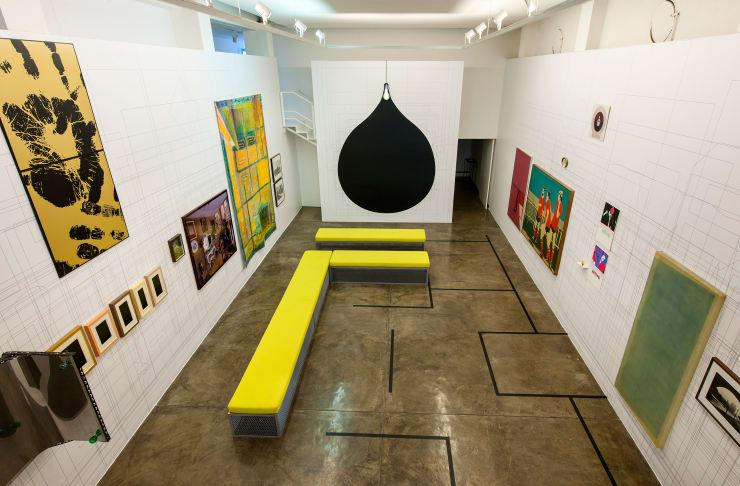Fernando Zarif
1960 – 2010, São Paulo, Brazil
A visionary and ceaseless questioner, Fernando Zarif produced a vast oeuvre, in which he established an authentic language independent from the cultural precepts of his time and associated with vanguard expressions such as performance art and video installations. Zarif is considered one of the most emblematic figures of the generation of artists from the city of São Paulo in the 1980s. From the 1990s onward, the artist began to appropriate various objects in his research, sometimes maintaining the integrity of their materials, sometimes not, but always resignifying them. Besides sculpture, video and performance, the artist explored other artistic supports, such as writing, drawing, painting and music.
Fernando Zarif studied architecture and took open courses in the arts. In 1982, he held his first solo show at the Gabinete Fotográfico of the Pinacoteca de São Paulo. The following year, he presented performances with music by Richard Wagner and John Cage, as part of the musical programming of the Museu de Arte de São Paulo Assis Chateaubriand (Masp). In 1995, he held his largest solo show at a Brazilian institution, at the Museu de Arte Moderna of Rio de Janeiro. In 1998, he had a solo show at the Maison des Arts et de la Culture André Malraux, in Créteil, France (1998). In 2009, he participated in his last show during life, at Espaço Tom Jobim, Rio de Janeiro. Beginning in 2011, his family began the Projeto Fernando Zarif, aimed at preserving, cataloging, and disseminating the artist’s work, with 2000 artworks recovered until today, including photographs, books, documents and writings. In 2015, the artist’s first large posthumous exhibition was held, at Instituto Figueiredo Ferraz, Ribeirão Preto, SP, followed by a show in honor of Zarif, held by Luciana Brito Galeria.
-
 Fernando ZarifSem título | Untitled, s.d.cobre
Fernando ZarifSem título | Untitled, s.d.cobre
cooper70 x 25 x 5 cm
27.56 x 9.84 x 1.97 inView more details -
 Fernando ZarifSem título | Untitled, s.d.papel, acrílica e madeira sobre tela
Fernando ZarifSem título | Untitled, s.d.papel, acrílica e madeira sobre tela
paper, acrylic, and wood on canvas50 x 40 x 2 cm
19.69 x 15.75 x 0.79 inView more details -
 Fernando ZarifSem título | Untitled, s.d.cobre
Fernando ZarifSem título | Untitled, s.d.cobre
cooper68 x 28 x 8 cm
26.77 x 11.02 x 3.15 inView more details -
 Fernando ZarifSem título | Untitled, s.d.folha de ouro, algodão, acrílico, plástico-bolha e fio sobre tela
Fernando ZarifSem título | Untitled, s.d.folha de ouro, algodão, acrílico, plástico-bolha e fio sobre tela
gold leaf, cotton, acrylic, bubble wrap, and thread on canvas97 x 85 x 6 cm
38.19 x 33.46 x 2.36 inView more details -
 Fernando ZarifSem título | Untitled, s.d.fuligem sobre tela
Fernando ZarifSem título | Untitled, s.d.fuligem sobre tela
soot on canvas30 x 30 x 4 cm
11.81 x 11.81 x 1.57 inView more details -
 Fernando ZarifSem título | Untitled, s.d.acrílica sobre tela
Fernando ZarifSem título | Untitled, s.d.acrílica sobre tela
acrylic on canvas122 x 80 cm
48.03 x 31.50 inView more details -
 Fernando ZarifSem título | Untitled, s.d.cobre
Fernando ZarifSem título | Untitled, s.d.cobre
copper63 x 13 x 25 cm
24.80 x 5.12 x 9.84 inView more details -
 Fernando ZarifSem título | Untitled, s.d.grafite sobre tela
Fernando ZarifSem título | Untitled, s.d.grafite sobre tela
graphite on canvas120 x 80 x 2 cm
47.24 x 31.50 x 0.79 inView more details -
 Fernando ZarifSem título | Untitled, s.d.técnica mista sobre papel
Fernando ZarifSem título | Untitled, s.d.técnica mista sobre papel
mixed media on paper200 x 156 cm
78.74 x 61.42 inView more details -
 Fernando ZarifSem título | Untitled, 2001papel e acrílica sobre tela
Fernando ZarifSem título | Untitled, 2001papel e acrílica sobre tela
paper and acrylic on canvas50 x 40 x 2 cm
19.69 x 15.75 x 0.79 inView more details -
 Fernando ZarifOperação Plástica | Chirurgie Esthétique, 1997técnica mista sobre tela
Fernando ZarifOperação Plástica | Chirurgie Esthétique, 1997técnica mista sobre tela
mixed media on canvas22 x 15 cm
8.66 x 5.51 inView more details -
 Fernando ZarifSem título | Untitled, 1996ossos de resina e cadeados
Fernando ZarifSem título | Untitled, 1996ossos de resina e cadeados
bone resin and padlocks55 x 12 x 11 cm
21.65 x 4.72 x 4.33 inView more details -
 Fernando Zarif"A Concepção de Buda (Naissance de Buddha)" | "The Conception of Buddha (Birth of Buddha)", 1994carvão sobre papel sobre tela
Fernando Zarif"A Concepção de Buda (Naissance de Buddha)" | "The Conception of Buddha (Birth of Buddha)", 1994carvão sobre papel sobre tela
charcoal on paper on canvas160 x 250 x 4 cm
62.99 x 98.43 x 1.57 inView more details -
 Fernando Zarif“Buddha”, 1994nanquim e guache sobre papel sobre tela
Fernando Zarif“Buddha”, 1994nanquim e guache sobre papel sobre tela
india ink and gouache on paper on canvas189 x 159 x 4 cm
74.41 x 62.60 x 1.57 inView more details -
 Fernando Zarif"Main de Michel Ange", 1990crayon e nanquim sobre papel impresso
Fernando Zarif"Main de Michel Ange", 1990crayon e nanquim sobre papel impresso
crayon and ink on printed paper288 x 252 cm (obra com 6 partes)
113.39 x 99.21 in (6 panels)View more details -
 Fernando Zarif"Zíper", c | Zippper, c, 1990cadeados
Fernando Zarif"Zíper", c | Zippper, c, 1990cadeados
padlocks70 x 10 x 5 cm
27.56 x 3.94 x 1.97 inView more details -
 Fernando Zarif"Europa 3" | Europe 3, 1989guache sobre papel impresso sobre eucatex
Fernando Zarif"Europa 3" | Europe 3, 1989guache sobre papel impresso sobre eucatex
gouache on printed paper mounted on Eucatex149 x 94,5 cm
58.66 x 37.20 inView more details -
 Fernando Zarif"Europa 3" | Europe 3, 1989nanquim e caneta hidrográfica sobre papel impresso
Fernando Zarif"Europa 3" | Europe 3, 1989nanquim e caneta hidrográfica sobre papel impresso
Ink and felt-tip pen on printed paper70 x 102 x 3 cm
27.56 x 40.16 x 1.18 inView more details -
 Fernando ZarifSem título | Untitled, 1981lã, cordões de seda e acrílica sobre tela
Fernando ZarifSem título | Untitled, 1981lã, cordões de seda e acrílica sobre tela
wool, silk cords and acrylic on canvas50 x 60 cm
19.68 x 23.62 inView more details -
 Fernando ZarifSem título (Retrato), c Untitled (Portrait), c, 1980técnica mista sobre tela
Fernando ZarifSem título (Retrato), c Untitled (Portrait), c, 1980técnica mista sobre tela
mixed media on canvas22 x 15 cm
8.66 x 5.91 inView more details -
 Fernando ZarifSem título (Retrato), c Untitled (Portrait), c, 1980técnica mista sobre tela
Fernando ZarifSem título (Retrato), c Untitled (Portrait), c, 1980técnica mista sobre tela
mixed media on canvas22 x 15 cm
8.66 x 5.91 inView more details -
 Fernando ZarifSem título (Retrato), c Untitled (Portrait), c, 1980técnica mista sobre tela
Fernando ZarifSem título (Retrato), c Untitled (Portrait), c, 1980técnica mista sobre tela
mixed media on canvas22 x 15 cm
8.66 x 5.91 inView more details -
 Fernando ZarifSem título (Retrato), c Untitled (Portrait), c, 1980técnica mista sobre tela
Fernando ZarifSem título (Retrato), c Untitled (Portrait), c, 1980técnica mista sobre tela
mixed media on canvas22 x 15 cm
8.66 x 5.91 inView more details -
 Fernando ZarifSem título (Retrato), c | Untitled (Portrait), c, 1980técnica mista sobre tela
Fernando ZarifSem título (Retrato), c | Untitled (Portrait), c, 1980técnica mista sobre tela
mixed media on canvas22 x 15 cm
8.66 x 5.91 inView more details -
 Fernando ZarifSem título (Retrato), c | Untitled (Portrait), c, 1980técnica mista sobre tela
Fernando ZarifSem título (Retrato), c | Untitled (Portrait), c, 1980técnica mista sobre tela
mixed media on canvas22 x 15 cm
8.66 x 5.91 inView more details -
 Fernando ZarifSem título (Retrato), c | Untitled (Portrait), c, 1980técnica mista sobre tela
Fernando ZarifSem título (Retrato), c | Untitled (Portrait), c, 1980técnica mista sobre tela
mixed media on canvas22 x 15 cm
8.66 x 5.91 inView more details -
 Fernando ZarifSem título (Retrato), c | Untitled (Portrait), c, 1980técnica mista sobre tela
Fernando ZarifSem título (Retrato), c | Untitled (Portrait), c, 1980técnica mista sobre tela
mixed media on canvas22 x 15 cm
8.66 x 5.91 inView more details -
 Fernando ZarifSem título (Retrato), c | Untitled (Portrait), c, 1980técnica mista sobre tela
Fernando ZarifSem título (Retrato), c | Untitled (Portrait), c, 1980técnica mista sobre tela
mixed media on canvas22 x 15 cm
8.66 x 5.91 inView more details -
 Fernando ZarifSem título (Retrato), c | Untitled (Portrait), c, 1980técnica mista sobre tela
Fernando ZarifSem título (Retrato), c | Untitled (Portrait), c, 1980técnica mista sobre tela
mixed media on canvas22 x 15 cm
8.66 x 5.91 inView more details -
 Fernando ZarifSem título (Retrato), c | Untitled (Portrait), c, 1980técnica mista sobre tela
Fernando ZarifSem título (Retrato), c | Untitled (Portrait), c, 1980técnica mista sobre tela
mixed media on canvas22 x 15 cm
8.66 x 5.91 inView more details -
 Fernando ZarifSem título (Retrato), c | Untitled (Portrait), c, 1980técnica mista sobre tela
Fernando ZarifSem título (Retrato), c | Untitled (Portrait), c, 1980técnica mista sobre tela
mixed media on canvas22 x 15 cm
8.66 x 5.91 inView more details -
 Fernando ZarifSem título (Retrato), c | Untitled (Portrait), c, 1980técnica mista sobre tela
Fernando ZarifSem título (Retrato), c | Untitled (Portrait), c, 1980técnica mista sobre tela
mixed media on canvas22 x 15 cm
8.66 x 5.91 inView more details -
 Fernando ZarifSem título (Retrato), c | Untitled (Portrait), c, 1980técnica mista sobre tela
Fernando ZarifSem título (Retrato), c | Untitled (Portrait), c, 1980técnica mista sobre tela
mixed media on canvas22 x 15 cm
8.66 x 5.91 inView more details -
 Fernando ZarifSem título (conjunto de rostos) | Untitled (set of faces)plástico e parafina
Fernando ZarifSem título (conjunto de rostos) | Untitled (set of faces)plástico e parafina
plastic and paraffin35 x 30 x 4 cm
13.77 x 11.81 x 1.57 inView more details -
 Fernando ZarifSem título (Dirac Nada Borboleta) | Untitled (Dirac Nothing Butterfly)técnica mista sobre papel
Fernando ZarifSem título (Dirac Nada Borboleta) | Untitled (Dirac Nothing Butterfly)técnica mista sobre papel
mixed media on paper200 x 263 cm
78.74 x 103.54 inView more details -
 Fernando ZarifSem título (Masque) | Untitled (Masque)plástico, madeira e plástico laminado
Fernando ZarifSem título (Masque) | Untitled (Masque)plástico, madeira e plástico laminado
plastic, wood and laminated plastic40 x 30 x 11,5 cm
15.74 x 11.81 x 4.52 inView more details -
 Fernando ZarifSem título | Untitledacrílica sobre tela
Fernando ZarifSem título | Untitledacrílica sobre tela
acrylic on canvas100 x 60 x 2 cm
39.37 x 23.62 x 0.79 inView more details -
 Fernando ZarifSem título | Untitledacrílica sobre tela
Fernando ZarifSem título | Untitledacrílica sobre tela
acrylic on canvas120 x 80 x 3,7 cm
47.24 x 31.50 x 1.46 inView more details -
 Fernando ZarifSem título | Untitledacrílica sobre tela
Fernando ZarifSem título | Untitledacrílica sobre tela
acrylic on canvas70 x 50 cm
27.56 x 19.69 inView more details -
 Fernando ZarifSem título | Untitledacrílica sobre papel
Fernando ZarifSem título | Untitledacrílica sobre papel
acrylic on paper50 x 60 cm
19.68 x 23.62 inView more details -
 Fernando ZarifSem título | Untitledacrílica, metal, incisões e colagem de papel sobre tela
Fernando ZarifSem título | Untitledacrílica, metal, incisões e colagem de papel sobre tela
acrylic, metal, incisions and collage on canvas97 x 147 cm
38.18 x 57.48 inView more details -
 Fernando ZarifSem título | Untitledlã, acrílica e ponta seca sobre tela
Fernando ZarifSem título | Untitledlã, acrílica e ponta seca sobre tela
wool, acrylic and drypoint on canvas50 x 60 cm
19.68 x 23.62 inView more details -
 Fernando ZarifSem título | Untitledacrílica e partículas sólidas sobre tela
Fernando ZarifSem título | Untitledacrílica e partículas sólidas sobre tela
acrylic and solid particles on canvas50 x 60 cm
19.68 x 23.62 inView more details -
 Fernando ZarifSem título | Untitledacrílica e guache sobre tela
Fernando ZarifSem título | Untitledacrílica e guache sobre tela
acrylic and gouache on paper50 x 60 cm
19.68 x 23.62 inView more details -
 Fernando ZarifSem título | Untitledacrílica e ponta seca sobre tela
Fernando ZarifSem título | Untitledacrílica e ponta seca sobre tela
acrylic and drypoint on canvas46 x 39,5 cm
18.11 x 15.55 inView more details -
 Fernando ZarifSem título | Untitledlã e acrílica sobre tela
Fernando ZarifSem título | Untitledlã e acrílica sobre tela
wool and acrylic on canvas60 x 50 cm
23.62 x 19.68 inView more details -
 Fernando ZarifSem título | Untitledplastilina e metal
Fernando ZarifSem título | Untitledplastilina e metal
plasticine and metal13 x 5 x 6 cm
5.11 x 1.96 x 2.36 inView more details -
 Fernando ZarifSem título | Untitledplastilina
Fernando ZarifSem título | Untitledplastilina
plasticine10 x 10 x 7 cm
3.93 x 3.93 x 2.75 inView more details -
 Fernando ZarifSem título | Untitledacrílica sobre tela
Fernando ZarifSem título | Untitledacrílica sobre tela
acrylic on canvas40 x 30 cm
15.75 x 11.81 inView more details -
 Fernando ZarifSem título | Untitledacrílica sobre tela
Fernando ZarifSem título | Untitledacrílica sobre tela
acrylic on canvas50 x 30 cm
19.69 x 11.81 in
View more details -
 Fernando ZarifSem título | Untitledacrílica sobre tela
Fernando ZarifSem título | Untitledacrílica sobre tela
acrylic on canvas50 x 40 cm
19.69 x 15.75 in
View more details -
 Fernando ZarifSem título | Untitledacrílica sobre tela
Fernando ZarifSem título | Untitledacrílica sobre tela
acrylic on canvas70 x 50 cm
27.56 x 19.69 in
View more details -
 Fernando ZarifSem título | Untitledacrílica sobre tela
Fernando ZarifSem título | Untitledacrílica sobre tela
acrylic on canvas80 x 60 x 4 cm
31.50 x 23.62 x 1.57 inView more details -
 Fernando ZarifSem título | Untitledacrílica sobre tela
Fernando ZarifSem título | Untitledacrílica sobre tela
acrylic on canvas100 x 60 x 2 cm
39.37 x 23.62 x 0.79 inView more details -
 Fernando ZarifSem título | Untitledacrílica sobre tela
Fernando ZarifSem título | Untitledacrílica sobre tela
acrylic on canvas70 x 90 x 4 cm
27.56 x 35.43 x 1.57 in
View more details -
 Fernando ZarifSem título | Untitlednanquim sobre papel
Fernando ZarifSem título | Untitlednanquim sobre papel
india ink on paper35,8 x 25,3 cm
14.09 x 9.96 inView more details -
 Fernando ZarifSem título | Untitledcrayon e aquarela sobre papel
Fernando ZarifSem título | Untitledcrayon e aquarela sobre papel
crayon and watercolor on paper32 x 24 cm
12.60 x 9.45 inView more details -
 Fernando ZarifSem título | Untitlednanquim sobre papel
Fernando ZarifSem título | Untitlednanquim sobre papel
india ink on paper35,8 x 25,3 cm
14.09 x 9.96 inView more details -
 Fernando ZarifSem título | Untitlednanquim sobre papel
Fernando ZarifSem título | Untitlednanquim sobre papel
india ink on paper35,7 x 25,3 cm
14.06 x 9.96 inView more details -
 Fernando ZarifSem título | Untitlednanquim sobre papel
Fernando ZarifSem título | Untitlednanquim sobre papel
india ink on paper35,7 x 25,3 cm
14.06 x 9.96 inView more details -
 Fernando ZarifSem título | Untitledacrílica sobre tela
Fernando ZarifSem título | Untitledacrílica sobre tela
acrylic on canvas70 x 60 cm
27.56 x 23.62 inView more details -
 Fernando ZarifSem título | Untitlednanquim sobre papel
Fernando ZarifSem título | Untitlednanquim sobre papel
india ink on paper35,7 x 25,3 cm
14.06 x 9.96 inView more details -
 Fernando ZarifSem título | Untitledacrílica e spray sobre tela
Fernando ZarifSem título | Untitledacrílica e spray sobre tela
acrylic and spray on canvas60 x 50 cm
23.62 x 19.69 inView more details -
 Fernando ZarifSem título | Untitledacrílica sobre tela
Fernando ZarifSem título | Untitledacrílica sobre tela
acrylic on canvas27 x 19 cm
10.63 x 7.48 inView more details
-

Dividing Line
21 August - 26 September 2020Luciana Brito Galeria is pleased to announce a group show online Dividing Line. Inspired by Regina Silveira’s artwork of the same name, the show presents a set of works that...Read more -

Fernando Zarif
2 February - 9 March 2019Luciana Brito Galeria inaugurates its 2019 program with a solo show by Fernando Zarif (São Paulo, 1960 – 2010). A fundamental persona of São Paulo’s cultural scene as of the...Read more -

15
27 November - 27 February 2015Curated by Jacopo Crivelli Visconti, Maria Montero and Rafael Vogt Maia Rosa, the show is the last one presented in the space at Gomes de Carvalho street, as in 2016 the gallery will move to a house designed by Rino Levi at Jardim Europa. The selection of works includes pieces by artists such as Regina Silveira, Nelson Leirner, Marina Abramović, Geraldo de Barros, Rochelle Costi, Caio Reisewitz, Thomaz Farkas and Tiago Tebet, exhibited exactly at the same location where they where originally shown in the gallery.Read more -

Fernando Zarif | Antes de começar termino
22 September - 12 November 2015The exhibition comprises a selection of around 15 works that reveal the importance of the drawing in his artistic process. Deceased in 2010, the artist’s multiple production has been recovered and catalogued since 2011 by the Project Fernando Zarif.Read more






